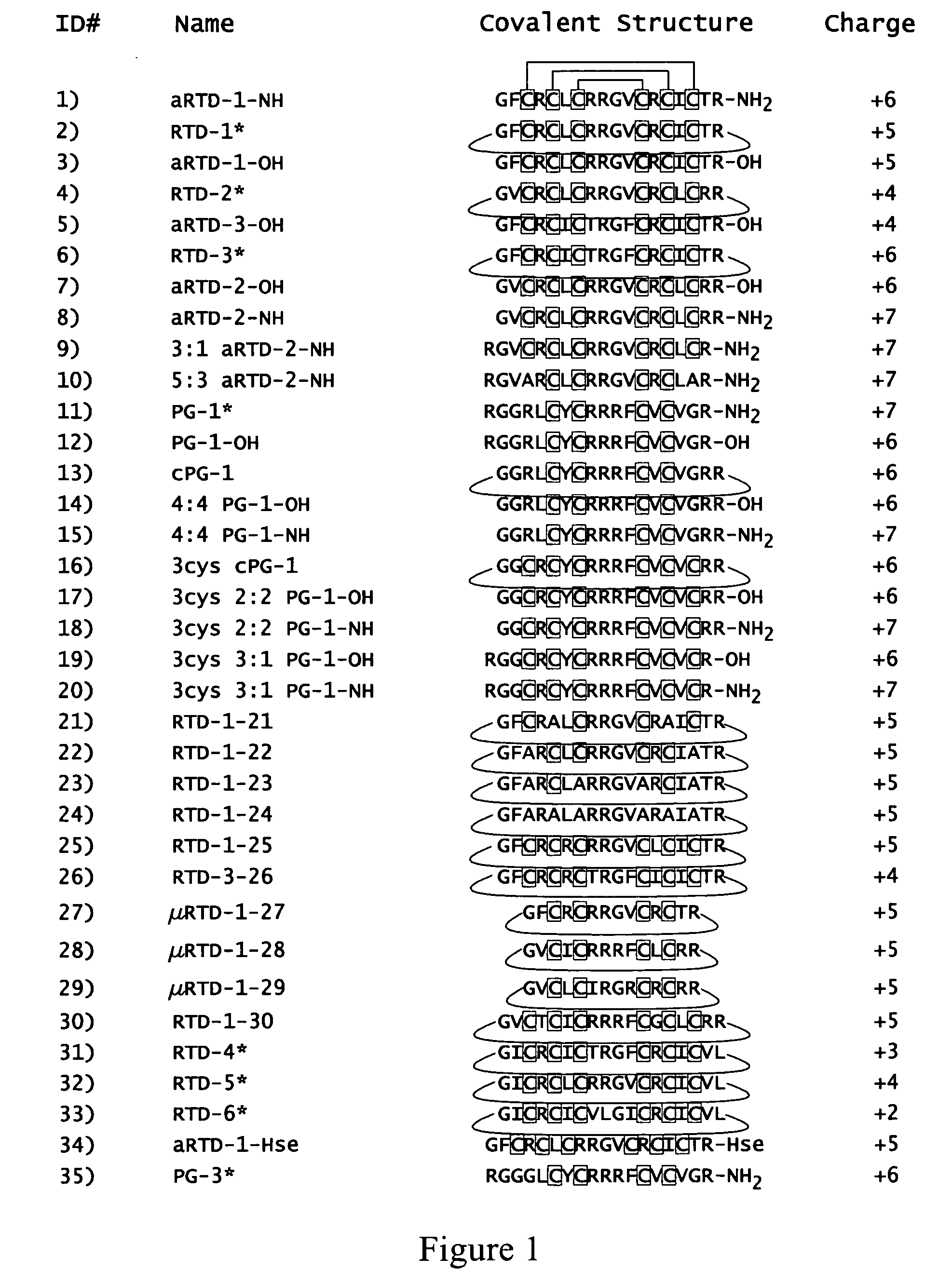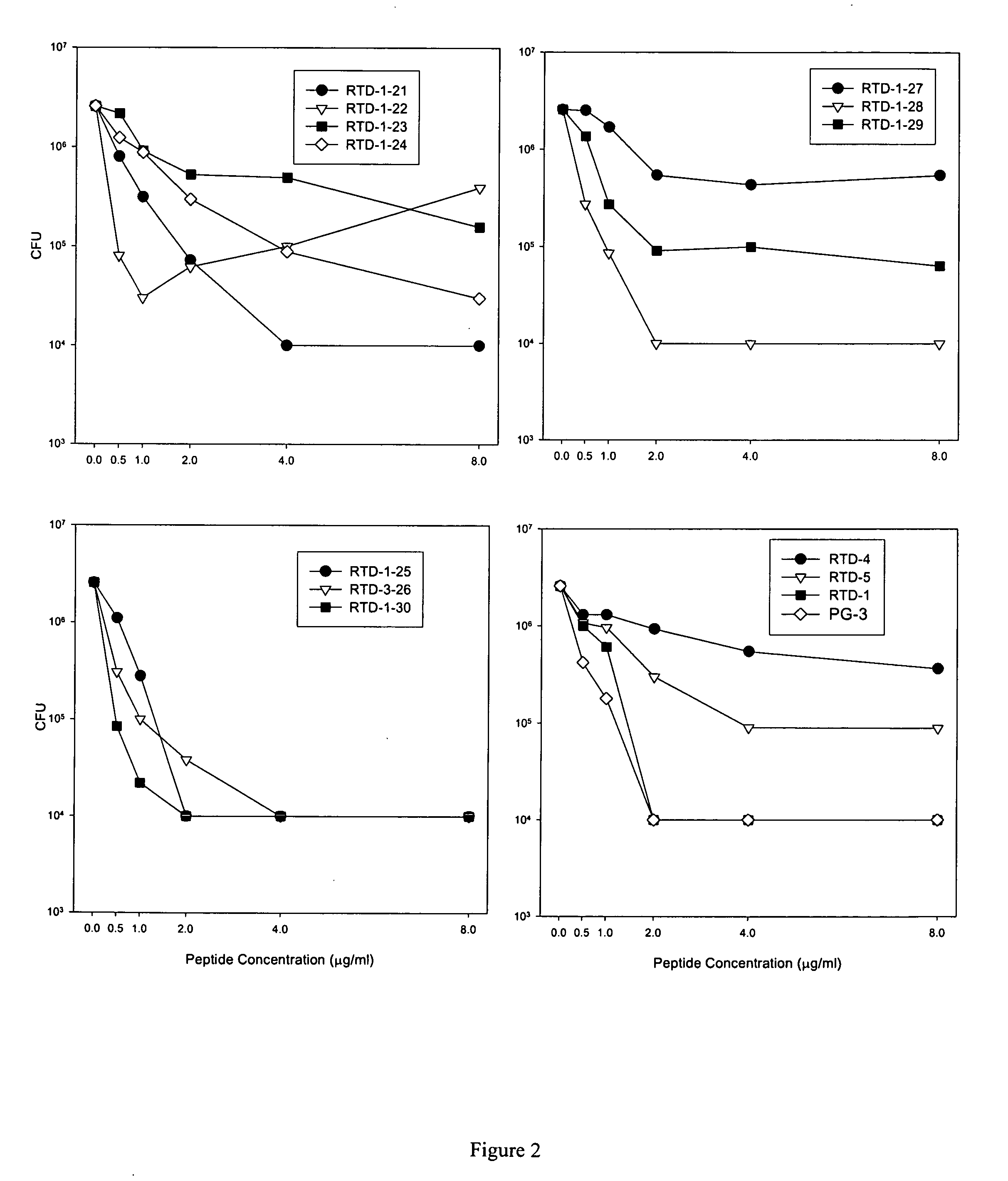Immunologic regulation by theta defensins
a technology of immunologic regulation and theta defensin, which is applied in the direction of biocide, drug composition, peptide/protein ingredients, etc., can solve the problems of increasing patient suffering, affecting the treatment effect, so as to inhibit the deleterious
- Summary
- Abstract
- Description
- Claims
- Application Information
AI Technical Summary
Benefits of technology
Problems solved by technology
Method used
Image
Examples
example i
Antimicrobial Activity of Theta Defensin Compounds In Vitro
[0096]This example describes assay methods and antimicrobial properties of theta defensin compounds assayed in vitro.
[0097]The antimicrobial activities of various theta defensin compounds were measured using a diffusion assay against bacteria (Staphylococcus aureus 502a and Escherichia coli ML35) and fungi (Candida albicans 16820 and Cryptococcus neoformans 271A). The antimicrobial activities were determined in an agar diffusion assay as described previously (Osapay et al., J. Biol. Chem. 275:12017-12022 (2000)). Briefly, 10-μl wells were bored in a 9-cm2 plate of agarose, buffered with 10 mM 1,4-piperazine-bis(ethanesulfonic acid) (PIPES), pH 7.4, containing 5 mM glucose, and seeded with 1×106 mid-log phase cells. Five-μl aliquots of each peptide, dissolved in 0.01% acetic acid (HOAc) at 10-300 μg / ml, were added to each well. After incubation at 37° C. for 2 h, the seeded agar was overlaid with molten agarose containing 6% ...
example ii
Antimicrobial Activity of Theta Defensins in Physiological Salts and Serum
[0102]This examples describes the antimicrobial activities of theta defensins in physiological salts and serum.
[0103]Staphylocidal activities of theta defensins and protegrin were assayed in various buffers and salt concentrations. Log-phase bacteria were incubated for 2 h at 37° C. with increasing concentrations of the peptides (FIG. 9). Cells were incubated with increasing concentrations of RTD-1 (filled circles), RTD-2 (filled triangles), RTD-3 (filled squares), and PG-1 (filled diamonds) in 10 mM PIPES (FIG. 9A), 10 mM Tris-Cl (FIG. 9B), or 10 mM sodium phosphate (FIG. 9C), at pH 7.4, containing 154 mM NaCl. As shown in FIG. 9, RTD-2 and RTD-3 exhibited more potent antimicrobial activity in the presence of salt compared to RTD-1, even though the structures of these theta defensins are very similar.
[0104]The bactericidal activities of theta defensins against E. coli in various physiological salt concentrati...
example iii
Anti-HIV Activities of Theta Defensins
[0107]This example describes anti-retroviral activity of theta defensins against human immunodeficiency virus (HIV).
[0108]The activities of RTD-1 and acyclic-RTD-1-Hse against HIV were tested. FIG. 12 shows the structures of RTD-1 and acyclic-RTD-1-Hse (aRTD-1-Hse). Peptide aRTD-1-Hse was produced as described previously (see, for example, US 20040014669, which is incorporated herein by reference).
[0109]FIG. 13 shows anti-HIV activities of theta and beta defensins. Phytohaemagglutinin (PHA)-stimulated peripheral blood mononuclear cells (PBMCs), pre-incubated for 3 hours with serial dilutions of defensins, were mixed with 1000 TCID50 (50% infectivity of susceptible cells in tissue culture) of a primary R5 strain of HIV-1. Two hours later, the cells were washed, and fresh medium containing defensin and 20 U / ml of IL-2 was added. Five days after infection, 50% of the medium was removed and replaced with fresh medium containing defensin and IL-2. On...
PUM
| Property | Measurement | Unit |
|---|---|---|
| Antimicrobial properties | aaaaa | aaaaa |
Abstract
Description
Claims
Application Information
 Login to View More
Login to View More - R&D
- Intellectual Property
- Life Sciences
- Materials
- Tech Scout
- Unparalleled Data Quality
- Higher Quality Content
- 60% Fewer Hallucinations
Browse by: Latest US Patents, China's latest patents, Technical Efficacy Thesaurus, Application Domain, Technology Topic, Popular Technical Reports.
© 2025 PatSnap. All rights reserved.Legal|Privacy policy|Modern Slavery Act Transparency Statement|Sitemap|About US| Contact US: help@patsnap.com



